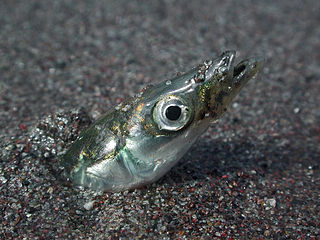
A sand lance or sandlance is a fish belonging to the family Ammodytidae. Several species of sand lances are commonly known as "sand eels", though they are not related to true eels. Another variant name is launce, and all names of the fish are references to its slender body and pointed snout. The family name means "sand burrower", which describes the sand lance's habit of burrowing into sand to avoid tidal currents.

Chromis is a genus of fish in the family Pomacentridae. While the term damselfish describes a group of marine fish including more than one genus, Chromis is the largest genus of damselfishes. Certain species within the genus are common in the aquarium trade.

Myripristis is a genus of soldierfishes.

Synodus is a genus of fish in the family Synodontidae found in Atlantic, Indian, and Pacific Oceans.
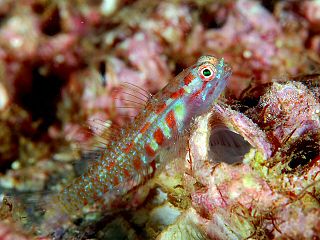
Eviota is a genus of fish in the family Gobiidae, commonly as dwarfgobies found in the Indo-Pacific region, where it is distributed from Japan to Australia and from Africa to Pitcairn Island. Species are mainly associated with coral reefs. Many of these fish are short-lived, with life cycles as brief as 3.5 weeks in the tropics. Some species are hermaphrodites and some representatives live symbiotically among the tentacles of the mushroom coral.

Rhinogobius is a genus of primarily freshwater gobies in the family Oxudercidae, native to tropical and temperate parts of eastern Asia. Most are small, streamlined in shape, and often sexually dimorphic. Few are of commercial importance, but R. duospilus is fairly widely traded as an aquarium fish.

Pseudanthias is a genus of colourful reef fishes of the subfamily Anthiinae, part of the family Serranidae, the groupers and sea basses. They are found in the Indo-Pacific. The species belonging to this genus have a diet consisting of zooplankton, and are haremic. Fishes currently included in this genus were earlier part of the genus Anthias. Pseudanthias is the largest anthiine genus

Halichoeres are a genus of wrasses found in the Atlantic, Indian and Pacific Oceans.

Trichonotus is a genus of marine gobiiform fishes. Species of Trichonotus are distributed throughout the Indo-West Pacific. This genus is the only member of the family Trichonotidae.
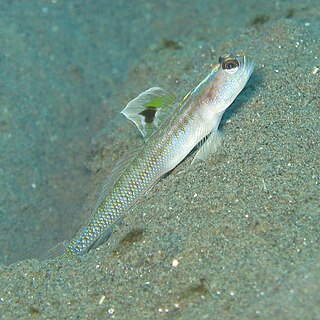
Vanderhorstia is a genus of gobies native to the Indian and Pacific oceans. The name of this genus honours the Dutch biologist Cornelius van der Horst (1889-1951) of the University of the Witwatersrand, Johannesburg, who was well known for his interest in marine biology.

Tomiyamichthys is a genus of gobies found from the Red Sea through the Indian Ocean to the western Pacific Ocean.
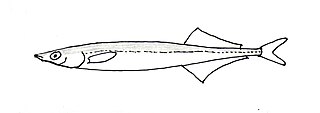
The Korean sandlance is a species of marine ray-finned fish belonging to the family Hypoptychidae. The Korean sandlance is the only species in this monotypic family and genus and is found in the northwestern Pacific Ocean.

Parapercis is a genus of sandperches belonging to the family Pinguipedidae.

Ammodytes is a genus of sand lances native to the northern oceans.
Bleekeria is a genus of sand lances native to the Indian Ocean and the western Pacific Ocean.
Protammodytes is a genus of sand lances found in the Atlantic and Pacific oceans.

Cabillus is a genus of gobies native to the Indian and Pacific oceans.

Novaculops is a genus of wrasses native to the Indian and Pacific Oceans.
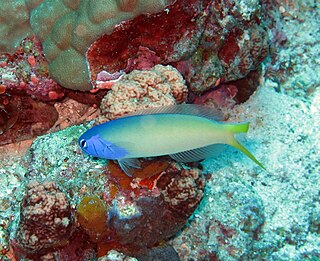
Hoplolatilus is a genus of tilefishes native to the Indian Ocean and the western Pacific Ocean. The chameleon tilefish (Hoplolatilus chlupatyi), also known as the flashing tilefish, is well known in particular in the aquarium hobby due to its unique ability to change colors in an instant with the help of specialized proteins in its skin that can reflect light in different wavelengths, allowing it to cycle between primary and secondary colors on the light spectrum.
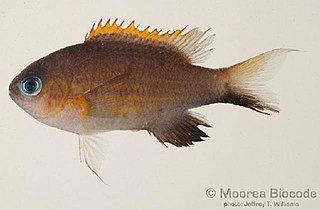
Pycnochromis is a genus belonging to the family Pomacentridae, the damselfishes and clownfishes, which is found in the Indian and Pacific Oceans.

















